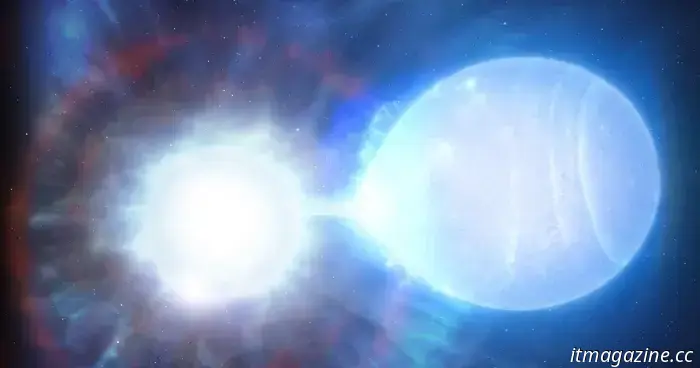
A duo of stars in our cosmic neighborhood is headed towards a collision.
In this image, we depict a binary system at the moment when the first white dwarf has just detonated, sending debris toward its nearby companion, which is also approaching its explosion. This event is predicted to happen in approximately 23 billion years, yet both stars will detonate in a span of just 4 seconds.
A significant cosmic occurrence is on the verge of happening close to home. Astronomers have identified a pair of stars that are destined to collide, situated merely 150 light-years from us. This collision will result in a supernova that will shine ten times brighter than the moon.
The binary system belongs to a rare category known as high mass compact binary star systems. While it is common for stars to exist in pairs, revolving around one another, it is unusual to find two such massive stars on a collision course.
“For years, a large and nearby double white dwarf binary has been anticipated, so when I first observed this system with a notably high total mass so close to our galaxy, I was thrilled,” stated lead researcher James Munday from the University of Warwick, UK. “With an international team of astronomers, including four from The University of Warwick, we quickly pursued this system using some of the largest optical telescopes available to ascertain its compactness.”
Upon observing the binary, Munday and his team found that the stars were remarkably close—just one sixtieth of the distance between the Earth and the sun. Additionally, the pair has a combined mass of 1.56 times that of the sun, indicating that they are destined to collide and produce a type of supernova known as 1a, although that will not occur for another 23 billion years.
Currently, the two stars orbit one another every 14 hours, but they will gradually spiral inwards until they complete an orbit in under a minute, ultimately leading to their collision.
“This discovery is highly significant,” remarked fellow researcher Ingrid Pelisoli from The University of Warwick. “Identifying such a system on our galactic doorstep suggests that they could be relatively common, as we would otherwise need to search farther afield in our galaxy to find them.
“However, discovering this system is just the beginning; our survey for type 1a supernova progenitors is ongoing, and we anticipate more exciting findings in the future. With each discovery, we are slowly unraveling the mystery surrounding the origins of type 1a explosions.”
The research findings are published in the journal Nature Astronomy.
Astronomers are gaining an unprecedented view of a monumental explosion in our ‘cosmic backyard.’
When considering the most intense events in the universe, one might think of supernovas or the collision of black holes creating ripples in spacetime. However, the most powerful explosions known to us are a specific phenomenon—Gamma-ray bursts—which we only partially comprehend. These bursts can last from milliseconds to hours and are a million trillion times brighter than the sun, releasing more energy in their brief duration than the sun will produce over its entire lifespan of 10 billion years.
A team of astronomers has documented the most powerful stellar flare ever recorded from our neighboring star, Proxima Centauri. This flare is 100 times stronger than any solar flare emitted by our sun, and it could have implications for the search for potentially habitable planets.
When NASA's James Webb Space Telescope launches next year, it may discover signs of life in an unexpected place—on planets that orbit dead stars known as white dwarfs.





Other articles
 Meta's newest open-source AI models compete with GPT, Gemini, and Claude.
Meta has introduced its Llama 4 series of open-source AI models, which includes Scout, Maverick, and Behemoth, aimed at competing with models developed by OpenAI and Google.
Meta's newest open-source AI models compete with GPT, Gemini, and Claude.
Meta has introduced its Llama 4 series of open-source AI models, which includes Scout, Maverick, and Behemoth, aimed at competing with models developed by OpenAI and Google.
 Analysis of the Nintendo Switch 2: How does it measure up against handheld PC gaming devices?
The Nintendo Switch 2 Direct revealed numerous surprises. With more information about the console now available, how does it compare to other handheld devices?
Analysis of the Nintendo Switch 2: How does it measure up against handheld PC gaming devices?
The Nintendo Switch 2 Direct revealed numerous surprises. With more information about the console now available, how does it compare to other handheld devices?
 NYT Crossword: solutions for Sunday, April 6.
The crossword puzzle in The New York Times can be challenging, even if it's not the Sunday edition! If you're facing difficulties, we're available to assist you with today’s clues and solutions.
NYT Crossword: solutions for Sunday, April 6.
The crossword puzzle in The New York Times can be challenging, even if it's not the Sunday edition! If you're facing difficulties, we're available to assist you with today’s clues and solutions.
 The Minecraft Movie achieved the highest opening weekend in the US for any video game adaptation.
A Minecraft Movie earned $301 million worldwide during its debut weekend.
The Minecraft Movie achieved the highest opening weekend in the US for any video game adaptation.
A Minecraft Movie earned $301 million worldwide during its debut weekend.
 Recap of Season 5 of The Handmaid's Tale
It's been some time since season five of The Handmaid's Tale aired, and with the arrival of season six, this recap of season five will be useful.
Recap of Season 5 of The Handmaid's Tale
It's been some time since season five of The Handmaid's Tale aired, and with the arrival of season six, this recap of season five will be useful.
 Don't expect an elaborate design update for the iPhone 17 Pro.
The iPhone 17 Pro is expected to enlarge the size of the camera bump, but it’s unlikely to feature any elaborate two-tone design or updates to the display aesthetics.
Don't expect an elaborate design update for the iPhone 17 Pro.
The iPhone 17 Pro is expected to enlarge the size of the camera bump, but it’s unlikely to feature any elaborate two-tone design or updates to the display aesthetics.
A duo of stars in our cosmic neighborhood is headed towards a collision.
Astronomers have found two stars that are headed towards a collision.
